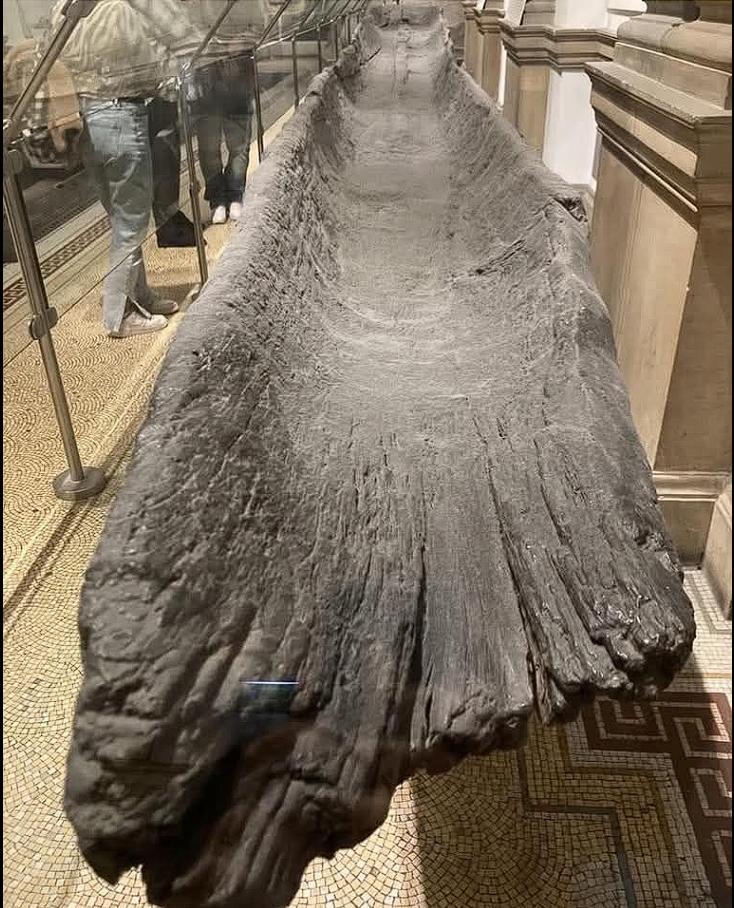“The Lurgan Canoe, a remarkable relic of Ireland’s prehistoric past, stands as a testament to the ingenuity and craftsmanship of its ancient inhabitants. Carved around 2000 BC and unearthed from a bog near Lurgan in County Galway, this 15-meter dugout canoe, one of Europe’s longest, offers a unique window into the lives, environment, and technological prowess of communities that thrived millennia ago. Its discovery and preservation, a story in itself, continue to illuminate the mysteries of Ireland’s ancient landscape.”
A Relic Unearthed: Unveiling a Prehistoric Vessel
- Discovery in the Bog:
- The canoe’s discovery in 1901, buried within the anaerobic environment of a bog near Lurgan, was a serendipitous moment that revealed a remarkably well-preserved artifact. This preservation, a result of the bog’s unique chemical properties, allowed for an unprecedented glimpse into the past.
- This discovery was not merely an archaeological find but a portal into a time when Ireland’s landscape and climate were vastly different, a time when ancient communities navigated waterways with ingenuity and skill.
- Preservation and Transformation:
- The canoe’s initial appearance, described as nearly white due to the bog’s preservation, was a stark contrast to its present rich hue. This transformation upon exposure to air underscored the delicate balance between preservation and decay, highlighting the challenges of archaeological conservation.
- This change in color, a visual representation of the passage of time, serves as a poignant reminder of the canoe’s journey from its ancient origins to its modern display in the National Museum of Ireland.
- Scale and Craftsmanship:
- Carved from the trunk of a giant oak tree, a species larger than any living in Ireland today, the canoe’s impressive 15-meter length speaks to the scale of the ancient forests and the skill of the artisans who crafted it.
- This feat of craftsmanship, requiring both technical expertise and a deep understanding of the material, highlights the advanced capabilities of Ireland’s prehistoric communities.
A Landscape Transformed: Mysteries of Ancient Ireland
- A Different Environment:
- The discovery of the canoe far from any substantial body of water adds to the mystery surrounding its use. This suggests dramatic shifts in the region’s climate and geography over the past four millennia.
- This discrepancy between the canoe’s location and the present-day landscape underscores the dynamic nature of Ireland’s environment and the importance of considering long-term geological changes.
- Ancient Navigation:
- The canoe’s design and scale indicate its use for navigating waterways, suggesting that ancient communities relied on water transportation for trade, migration, and communication.
- This reliance on water transportation highlights the importance of rivers and lakes in the lives of ancient Irish communities, shaping their settlements and cultural practices.
- Clues to Prehistoric Life:
- The Lurgan Canoe serves as a tangible link to the lives and craftsmanship of Ireland’s prehistoric communities. Its construction and use offer clues about their social organization, technological capabilities, and understanding of their environment.
- This artifact, therefore, is not merely a boat but a historical document, providing valuable insights into the daily lives and cultural practices of ancient Irish people.
A Legacy Preserved: Echoes in Dublin’s Museum
- National Museum of Ireland:
- The canoe’s current residence in the National Museum of Ireland – Archaeology in Dublin ensures its preservation and accessibility to researchers and the public.
- This placement allows for ongoing research and interpretation, contributing to our understanding of Ireland’s prehistoric past.
- Educational Significance:
- The Lurgan Canoe serves as an educational tool, offering visitors a tangible connection to Ireland’s ancient history and fostering an appreciation for the ingenuity and resilience of its prehistoric inhabitants.
- This artifact plays a crucial role in preserving and disseminating knowledge about Ireland’s cultural heritage, ensuring that the stories of its ancient communities are not forgotten.
- A Timeless Voyage:
- The Lurgan Canoe’s journey from a bog in County Galway to the National Museum in Dublin is a testament to its enduring significance. It continues to offer clues into the lives, craftsmanship, and environment of Ireland’s prehistoric communities.
- Its story, a timeless voyage through millennia, serves as a reminder of the enduring connection between past and present, highlighting the importance of preserving our cultural heritage.
Conclusion:
“The Lurgan Canoe, a 15-meter dugout carved from a giant oak tree, stands as a remarkable testament to the ingenuity and resilience of Ireland’s prehistoric inhabitants. Unearthed from a bog near Lurgan, this 4,000-year-old vessel offers a unique window into the lives, environment, and technological prowess of communities that thrived millennia ago. Its discovery and preservation, a story in itself, continue to illuminate the mysteries of Ireland’s ancient landscape, ensuring that its echoes resonate through time.”

CÁC TIN KHÁC
Mary Walton: The Forgotten Inventor Who Helped Clean Up America’s Cities
Tomb of Queen Nefertari in the Valley of the Queens, Egypt
Discover the Hypostyle Hall of the Temple of Hathor at Dendera
Venus de Losange: Unveiling the Mystery of a 20,000-Year-Old Paleolithic Icon